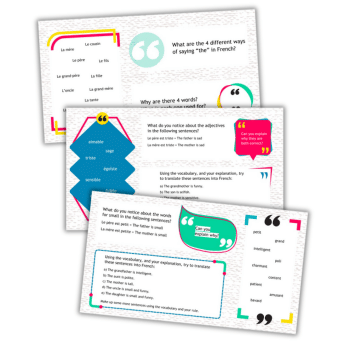MFL teaching – Use foreign media to create brilliant bespoke resources

Fiona Easton recalls how casting around for media materials outside of her school’s rapidly ageing textbooks helped to inject new life and urgency into her MFL lessons
- by Fiona Easton

As a newly qualified MFL teacher, I remember wanting to use foreign media materials in my lessons right from the start – but when you’re training, you don’t have enough time to spend hours poring over news articles in an effort to find something useful.
It was therefore something I brought in gradually. By the time I completed my second year of teaching, I’d resolved to use an authentic and topical news article in my classroom at least once a week.
This impulse initially grew out of my frustration with the textbooks we’d been using. I could tell that they would have been perfectly fine when first published, but that their contents had very quickly gone out of date. Teaching students with the help of material that they could also see had visibly dated was quite difficult, because it was hard for them to engage with.
Refining the process
Incorporating various media materials into lessons is something you would expect all MFL teachers to be doing to a certain extent, but in my experience, it rarely involved direct collaboration. When using a particularly good article, I might possibly share it with a departmental colleague – though at my last school, I’d typically be teaching one topic while my colleagues taught something else, or a different language entirely, so a media clipping that was useful for my lesson might not have been as relevant for what they were doing.
That said, we did find that centrally posting the articles we planning to use in class was quite useful. It soon got me wondering why I wasn’t seeing other language teachers consistently sharing article finds of their own online and via social media, which is what eventually inspired me to start sending out a regular newsletter (see ‘Inspiration to your inbox’).
Ultimately, it helped having just one topic per week that I needed to focus on. As someone who generally consumes news quite often, I’d usually be up on buzzwords and have a fairly good sense of what was going on. Combining up-to-the-minute and trending keyphrases with Google’s ‘News’ filter meant that sooner or later, I’d usually come across something appropriate that I could use.
At first, these searches could take quite a long time. Fairly soon, however, I developed a feel for which foreign news outlets and media channels were going to have useful material, and which would be less helpful. I began conducting larger scale, but less time consuming searches, and got into the habit of saving multiple articles to a hard drive so that I could refer back to them and use them in class when needed. There were many different ways of refining the process.
Endless options
Back when we were still using those dated textbooks, I remember how we once covered the topic of ‘everyday idols’ in our Spanish lessons – these being singers, musicians, actors and fashion models, the latter of whom were now of significantly less interest to young people than perhaps they once were.
I wanted to instead find something involving YouTubers and influencers, since they feature in young people’s lives far more prominently, and ended up using an article that discussed how some young content creators had become extremely rich during social media’s early growth years.
This was helpful for bringing the classroom discussion round to something students could relate to more closely. It turned out to be a good conversation prompt, while also being highly relevant to the topic we were studying.
There are many ways to approach using media materials in class, since they’re essentially base texts that you haven’t had to produce yourself. I’d sometime use written news media by way of a starter activity, and task students with hunting for examples of certain grammatical items.
There’s also the potential to create translation activities using the vocabulary drawn from certain example texts, or summary activities – different A Level exam boards will often set tasks that require students to read longer texts and attempt to summarise them in, say, 90 words. If you can find a media outlet that’s a reliable producer of audiovisual material, you could try creating your own listening activities – the options are pretty much endless.
Palpable enthusiasm
Over time, I saw how regular use of media helped to improve students’ engagement levels, but also the chances of productive spontaneity occurring within lessons. By using our own selections of up-to-date media examples and written materials, we could base activities around absorbing topics that were relevant to what was going on in our students’ lives, and things they’d already be talking about with their peers outside of class.
This had a noticeable impact on their willingness and ability to take part in speaking activities and wider class discussions. Unsurprisingly, they were much more likely to engage with lessons and contribute their opinions when not referring to news, fashions or developments that were last considered ‘current’ some five years ago…
It’s also worth pointing out that many teachers assume A Level language topics have to be quite dry, but that’s not the case. Don’t be afraid to search for and use material that actually interests you, as well as your students. Your resulting enthusiasm for the material will be palpable, and help to motivate them.
More broadly, this can usefully feed in to the requirement for A Level MFL students to complete an element of independent research. Ideally, they’ll want to choose an area they’re actively interested in learning and writing about. By introducing them to more diverse conversation topics and examples of foreign culture, you’ll be broadening their horizons and introducing them to concepts and ideas they might otherwise have never known existed.
Properly engage
When it comes to specific sources, in my case there are the obvious mainstream media outlets operating in France and Spain that come up a lot – Le Monde and El País for news, France 24 for rolling video news. But whichever sources you use, you should never find an article, quickly read the headline and think ‘That’ll do.’
You always need to have thoroughly read through and understood any media examples yourself, and properly engage with the material before deciding whether or not you can use it at a level that’s appropriate for the students you have.
You might have a class of three kids, all of whom are native speakers aiming for A*s, or you may have a group of 13 spanning a wide range of abilities. It’s down to the teacher to make sure that any media material you use is relevant, age appropriate and pitched at the right level.
Inspiration to your inbox
A while ago I started The MFL A Level News project – a weekly newsletter aimed at MFL teachers containing several links to news articles that could be effectively used to support your lessons. The project is still going, but has temporarily changed to a biweekly newsletter, owing to my work and study commitments.
When putting the newsletters together, I’ll cycle through a selection of different topics, pick one for a given week and share three to four links to news articles, each accompanied by a short description of the article in question, and frequently an idea or suggestion as to how it might be used effectively in a lesson.
I’ve received really positive feedback from readers thus far. It’s been nice to give something back to the MFL learning community, while hopefully also saving teachers valuable time.
Fiona Easton is an A Level teacher of French and Spanish, and currently head of A Level for the MFL resource provider Languagenut; for more information, visit languagenut.com
For details of how to sign up for MFL A Level News, follow @NewsMfl











